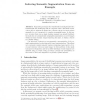Free Online Productivity Tools
i2Speak
i2Symbol
i2OCR
iTex2Img
iWeb2Print
iWeb2Shot
i2Type
iPdf2Split
iPdf2Merge
i2Bopomofo
i2Arabic
i2Style
i2Image
i2PDF
iLatex2Rtf
Sci2ools
ACCV
2006
Springer
2006
Springer
Inducing Semantic Segmentation from an Example
Segmenting an image into semantically meaningful parts is a fundamental and challenging task in computer vision. Automatic methods are able to segment an image into coherent regions, but such regions generally do not correspond to complete meaningful parts. In this paper, we show that even a single training example can greatly facilitate the induction of a semantically meaningful segmentation on novel images within the same domain: images depicting the same, or similar, objects in a similar setting. Our approach constructs a non-parametric representation of the example segmentation by selecting patch-based representatives. This allows us to represent complex semantic regions containing a large variety of colors and textures. Given an input image, we first partition it into small homogeneous fragments, and the possible labelings of each fragment are assessed using a robust voting procedure. Graph-cuts optimization is then used to label each fragment in a globally optimal manner.
| Added | 13 Jun 2010 |
| Updated | 13 Jun 2010 |
| Type | Conference |
| Year | 2006 |
| Where | ACCV |
| Authors | Yaar Schnitman, Yaron Caspi, Daniel Cohen-Or, Dani Lischinski |
Comments (0)

